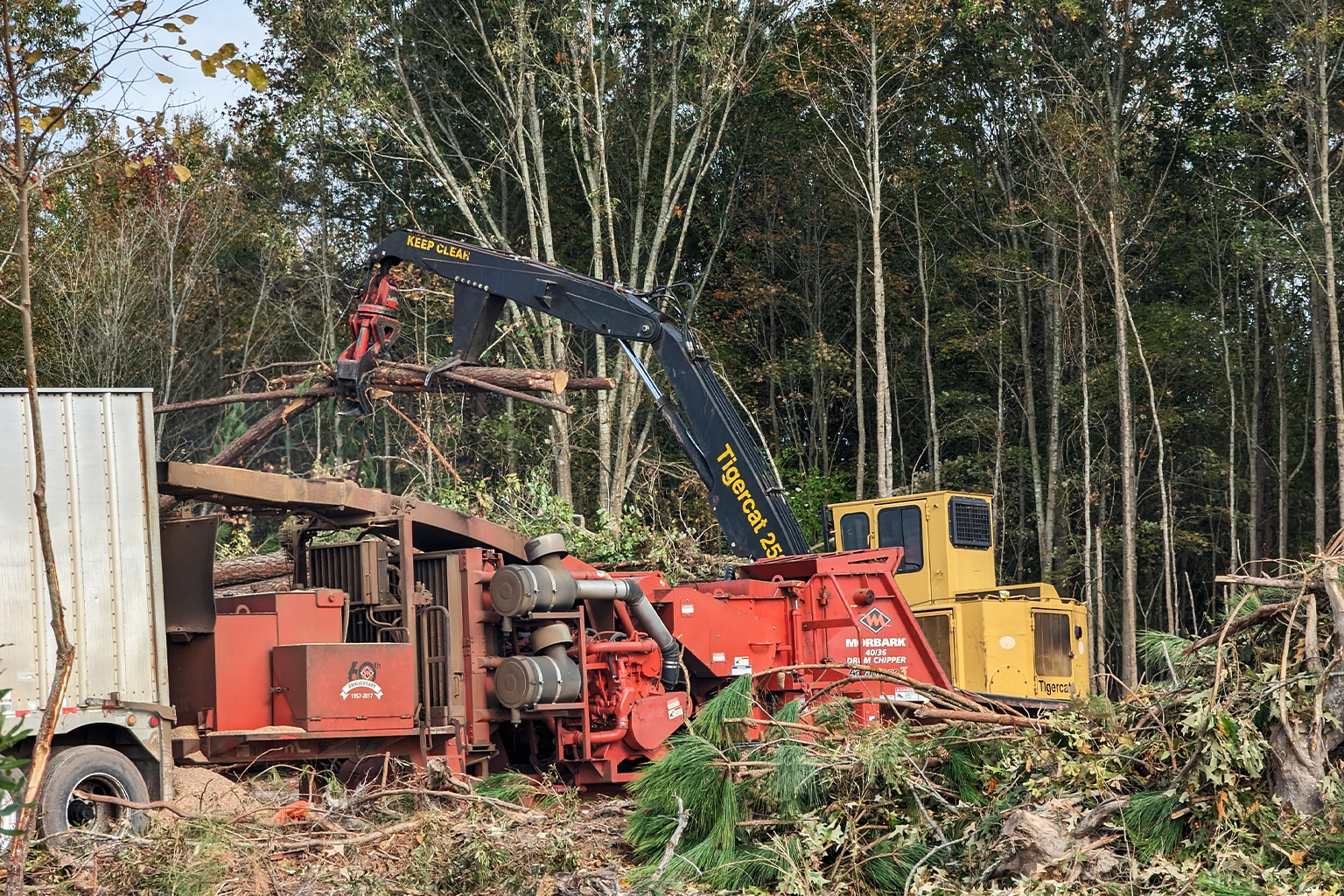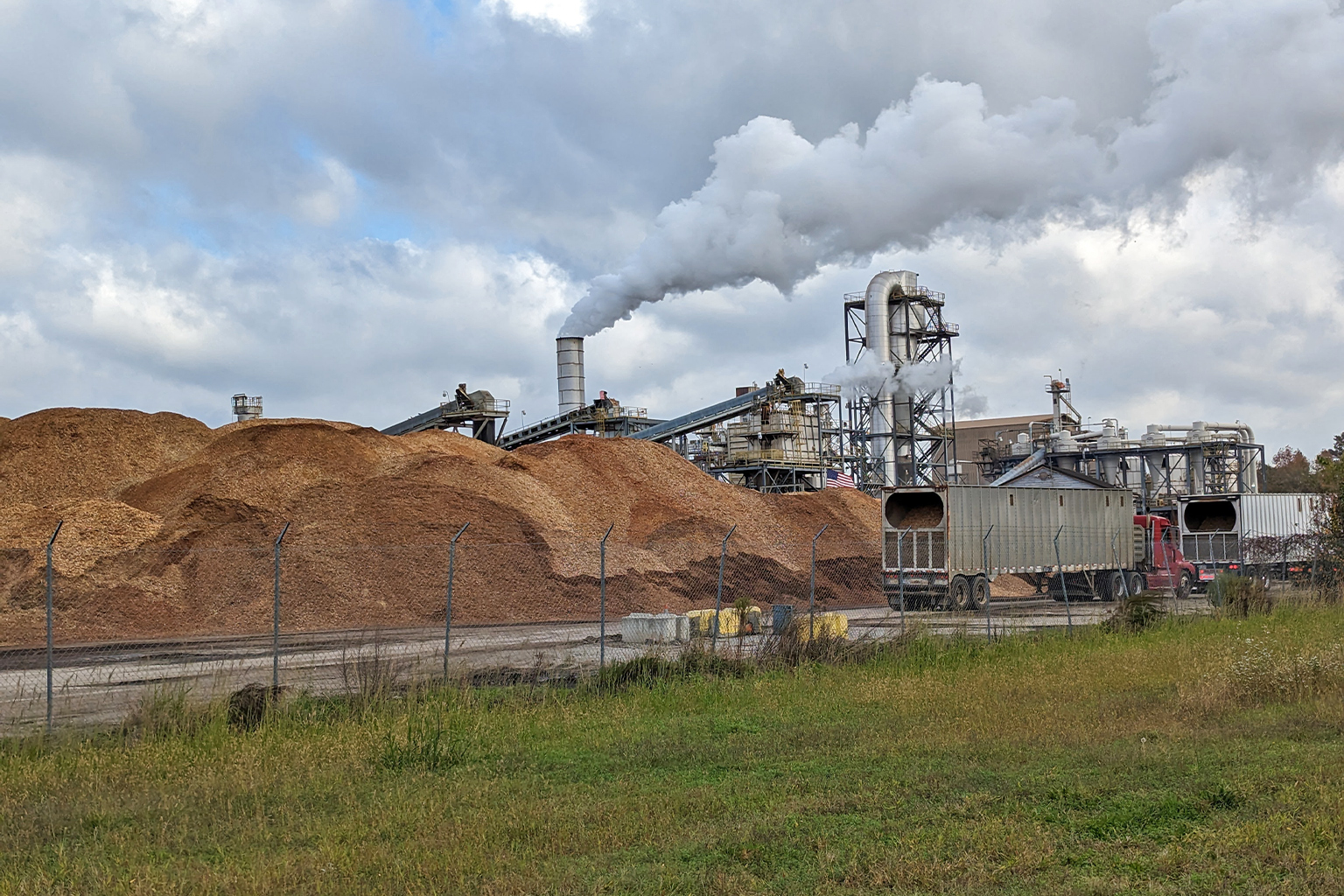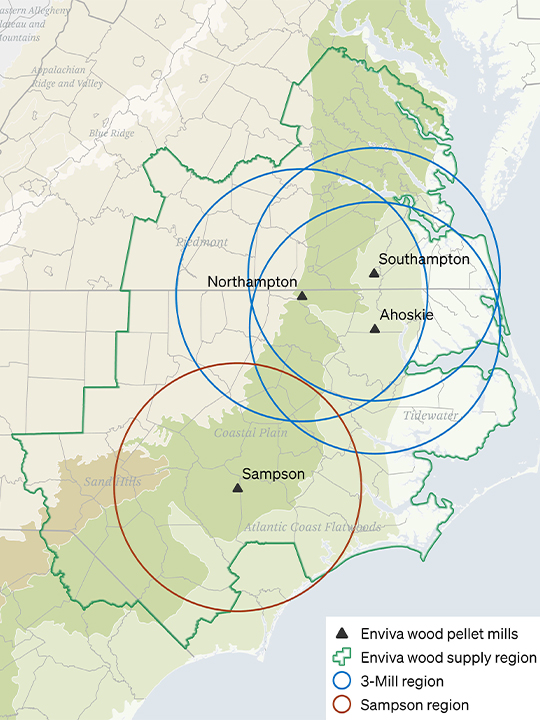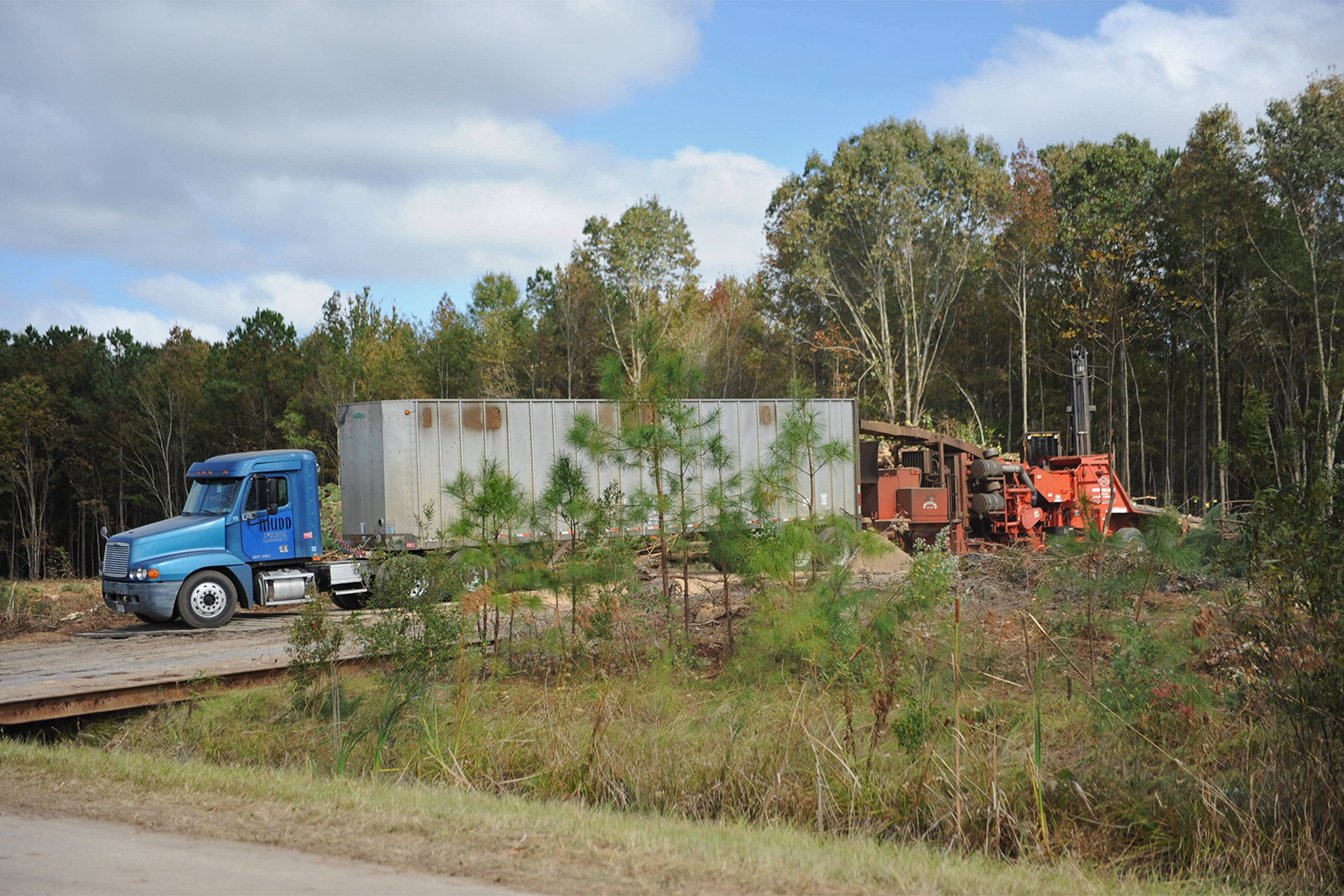- Enviva is the largest maker of wood pellets burned for energy in the world. The company has, from its inception, touted its green credentials.
- It says it doesn’t use big, whole trees, but only uses wood waste, “tops, limbs, thinnings, and/or low-value smaller trees” in the production of woody biomass burned in former coal power plants in the U.K., EU and Asia. It says it only sources wood from areas where trees will be regrown, and that it doesn’t contribute to deforestation.
- However, in first-ever interviews with a whistleblower who worked within Enviva plant management, Mongabay contributor Justin Catanoso has been told that all of these Enviva claims are false. In addition, a major recent scientific study finds that Enviva is contributing to deforestation in the U.S. Southeast.
- Statements by the whistleblower have been confirmed by Mongabay’s own observations at a November 2022 forest clear-cut in North Carolina, and by NGO photo documentation. These findings are especially important now, as the EU considers the future of forest biomass burning as a “sustainable” form of renewable energy.
EDENTON, North Carolina — The operator of a Tigercat tractor used its claw-like arm to skillfully scoop up what just days before had been a sizable old oak, as the clear-cut of a thickly wooded 52-acre (21-hectare) site in this coastal Southeastern U.S. town neared completion.
The Tigercat operator fed the big oak, along with several skinnier trees, into a 4-ton whole-tree drum chipper. With a roar, it instantaneously ground the long trees into a torrent of small wood chips that flew out a chute into a tractor-trailer. In less than 30 minutes, the trailer was filled with 40 tons of chips. Then another tractor-trailer backed up to take the first one’s place. The chipping and loading process continued — another forest patch cleared.
What I observed here while reporting for Mongabay on Nov. 3, 2022, corroborated what a biomass industry whistleblower had told me:
“We take giant, whole trees. We don’t care where they come from. The notion of sustainably managed forests is nonsense. We can’t get wood into the mills fast enough.”
The whistleblower had contacted me in early 2022, while still a wood pellet plant management official with the company Enviva. Since then, he had left the company, the world’s largest wood-pellet producer. But in every interview he offered a first-person exposé of the company’s practices: a revealing, first-of-its-kind account from inside the biomass-for-energy industry.

Enviva’s green image: A company-constructed fabrication
An onsite driver for the Mudd Trucking company confirmed to Mongabay that he was taking the Edenton load to Enviva’s wood pellet plant in Ahoskie, North Carolina, 37 miles (60 kilometers) away. He also told me he would make three or four more round trips that November day. A parade of trucks had been making runs to Ahoskie for two weeks from the site, and would do so until the dense, biodiverse forest — a sponge against coastal flooding, a haven for wildlife — was gone.
North Carolina is a wood-producing state and clear-cuts are common in the coastal plain. But since 2011, the construction and expansion of five Enviva wood pellet mills — four in North Carolina, one in southern Virginia — have increased demand for wood from intact, natural forests at a time when such forests are perhaps the region’s single-best tool for mitigating the impacts of climate change.
Ray Bateman, the logger in charge of the cut block, estimated that about half the trees went to Enviva; thicker roundwood went to nearby sawmills because it fetched a better price than chips. Limbs and spindly treetops lay on the ground all over the site, abandoned.
“The company says that we use mostly waste like branches, treetops and debris to make pellets,” the whistleblower told me. “What a joke. We use 100% whole trees in our pellets. We hardly use any waste. Pellet density is critical. You get that from whole trees, not junk.”

An Edenton city official informed Mongabay that, with wood prices high, the town decided to cash in on the trees this autumn and that the 52 acres were being cleared for future industrial development. There are no plans to replant the site with any new trees. But Enviva claims on its website that it only uses wood from sites that are replanted.
Enviva has 10 pellet plants in six Southeastern U.S. states. It produces roughly 6.2 million metric tons of wood pellets annually. That’s up from 1.7 million metric tons in 2015 when the company went public, more than tripling its output. In 2021, Enviva’s revenue topped $1 billion, more than twice what it grossed five years earlier.
Nearly all Enviva pellets are shipped to the United Kingdom, Europe or Asia, to be burned instead of coal to make energy. None of the countries there are required to report smokestack carbon emissions, because wood pellets — or woody biomass, as it’s called — are defined as a renewable energy source by policy. However, that burning does nothing to address the primary goal of climate mitigation: reducing real-world carbon emissions now.
On the landing page of Enviva’s website, over a gorgeous photo of a lush, green mountain range, it reads: “Displace Coal. Grow More Trees. Fight Climate Change.”
“We say we’re green. We say we care about the environment,” the whistleblower told me while still working for Enviva. “I get so tired of hearing one thing and seeing another.”

A whistleblower goes public
It was Earth Day, April 22, 2022, when CBS Mornings broadcast its story on wood pellet production in eastern North Carolina, with a focus on Enviva. With each viewing of the news report, the whistleblower seethed. Lies, he said. All lies.
On air, an Enviva spokesperson, Don Calloway, corrected the CBS reporter when he referenced vast stacks of limbless trees piled high at an Enviva wood pellet mill. “It’s important not to call them tree trunks,” Calloway said. “We take in tops; we take in limbs.”
Calloway also told CBS that Enviva never clear-cuts forests, while failing to mention that Enviva itself doesn’t cut a single tree: All tree harvesting for the company is done by logging contractors.
That nationally televised report was the last straw for the whistleblower, a senior department head at two Enviva plants for more than two years, with direct responsibility for maintenance reliability of pellet manufacturing equipment. He contacted me through the Mongabay website and said he wanted to talk — becoming the first insider within the global, multibillion-dollar wood pellet industry to go public with his observations and harsh criticisms.

Over the course of six months, I communicated with the source regularly and interviewed him on four separate occasions. The management employee requested that his name not be used. He left Enviva in the spring after his first interview for another job. While he told me Enviva will likely guess his identity, the whistleblower stressed that he has a family and a new career to protect and doesn’t want to risk current or future employment by using his name.
“Enviva knows my reputation is impeccable; I am a known entity in the reliability maintenance world,” he explained. “Those folks I worked for know I’m telling the truth. They can’t discredit me.”
After an Enviva spokesperson was briefed by Mongabay regarding this upcoming whistleblower story, as well as being informed of the former employee’s central criticisms, the company responded with a written statement:
“We are saddened and take issue by the allegations made by the former employee. The viewpoints expressed by this employee do not represent Enviva’s values nor are they accurate. While the source’s name was not revealed, we do not believe there is an employee fitting the description of what was shared that would have any credible or expert knowledge about the allegations made.”
Several other former Enviva plant employees declined Mongabay’s requests for interviews. One who did talk, a former woodyard manager who recently left the company, was less critical of Enviva. But he said he trusted the maintenance manager who was passionate about what he saw as contradictory statements and actions by Enviva that led his colleague to resign.
The woodyard manager, who also asked that his name not be used, said there was escalating pressure at Enviva pellet mills in the last few years to dramatically increase production to keep up with new overseas contracts. Still, he insisted that Enviva is environmentally conscious:
“We were told we will not purchase wood from any site that’s not going to be reforested once it’s cleared.”
In Edenton, Mongabay observed the exact opposite. Enviva accepted many tons of chipped trees from that site whose entire future use is publicly identified for industrial development.

Seeing the forest and the trees
Just before the recent United Nations COP27 climate summit in Egypt, the World Resources Institute (WRI) released a groundbreaking study that underlined the crucial role intact forests play in combating the climate crisis — a role that goes beyond how they absorb carbon as they grow, or release carbon when cleared or burned.
“Policymakers must heed clear evidence that forests are even more important for climate than previously thought,” WRI researchers wrote. “A growing body of research reveals that forests interact with the atmosphere in many ways other than through the global carbon cycle, affecting rainfall and temperature from global to local scales.”
They added: “In fact, forests’ non-carbon effects are not only essential for fighting climate change, but for food and water security, human health and the world’s ability to adapt to a warming planet.”
For generations, forests have fallen for many logical reasons: economic development, agriculture, plus a host of wood products that we rely on, such as building materials, furniture, paper, even fine acoustic musical instruments. But woody biomass made to burn in power plants is something relatively new — and controversial.

In the 12 years since Enviva built its first plant in North Carolina, the company and the rest of the wood pellet industry have seen explosive growth — buoyed by billions of dollars in overseas “green” subsidies and supported by national and international energy policies.
Today, countless trees continue being burned to make energy in former coal-fired power plants, with woody biomass technically designated a renewable energy source on par with wind and solar, and thus theoretically better than burning coal. But scientific research counters that it’s neither.
The devastating result has been a demand for wood during a climate crisis when intact, standing forests are more vital than ever to protecting the fate of humanity and the planet.
Wood pellet production has added dramatically to deforestation of old-growth forests in British Columbia, and in the Eastern European countries of Romania, Latvia and Estonia. It has also boosted Enviva’s size, global market share, profits, and demand for more trees. Enviva sources most of its trees in the Southeastern U.S., one of the nation’s largest carbon sinks and among its most biodiverse regions.
“Forests are so much more valuable than just carbon,” the WRI researchers wrote. “It’s time to see them for their full climate value — to benefit the people who live and work in and near them, hundreds of miles away, and all around the world.”

A career move from the oil industry to wood pellets
After earning a mechanical engineering degree from a top technology university, the former Enviva maintenance manager spent years working in various roles for a chemical company and two global oil companies, where he became an expert in equipment maintenance and in mitigating environmental hazards.
He explained to Mongabay how, over time, as he observed onsite environmental carelessness with chemicals, and unreported methane leaks from rusting storage tanks, his concern mounted over the harm his employers were doing to the environment.
Then in mid-2020, a recruiter with Enviva in Raleigh, North Carolina, contacted him.
“I liked what I heard. I believed what they told me up front, you know, their public statements about how they are sustainable and how they want to eliminate coal and build more forests. I knew a little bit about biomass, and I looked into it some more. And, you know, their website is very impressive.
“There’s this, too. My little girl, she’s in middle school, she’s really into the environment. I told her about the opportunity with Enviva. I told her I would be doing good things for the environment for a change. I believed that. And she was all happy when I got the job in North Carolina. I went in there thinking that we are on the leading edge of something that’s really good for the planet, right? And then, over time, you realize this is all nonsense; they don’t do any of this. It’s an eye-opener.”
The first Enviva plant at which the maintenance manager worked received tons of forest wood, but all of it already chipped at myriad harvest sites. The whistleblower described issues of fire safety at the plant, along with onsite groundwater and air pollution, plus challenges in keeping the machines humming from constant use. Still, overall, he believed he was on the right side of the environment with Enviva.
Then, a year later, he was transferred to a larger plant where its woodyard was stacked high with thousands of whole trees harvested within a 50-mile (80-km) radius, waiting to be chipped and pelletized.
“That’s when it kind of slapped me in the face. I was used to mounds of wood chips. But those trees on the lot were huge. They went on forever. And the trucks [carrying more trees] come all day, every day. I had no idea where they’re getting all that stuff, and it made me wonder: How can this be sustainable like they say?”

Good biomass, bad biomass
Enviva, as a publicly owned company, has an obligation to be transparent with its shareholders and with the public about its policies and practices. In meeting this obligation, this is what Jennifer Jenkins, Enviva’s former chief sustainability officer, wrote in a statement for the company website: “Not all biomass is good, and not all biomass is bad.”
“Good biomass,” Jenkins added, “is made of low-value wood that is a by-product of a sawmill operation or planned traditional timber harvest.” She further described good biomass as “tops, limbs, thinnings, and/or low-value smaller trees.”
Good biomass, she continued, did not come from “larger, high-value trees that instead could be used in longer-lived products.” Importantly, she wrote that good biomass “comes from a region where forest carbon stocks are stable or increasing … from harvest practices that safeguard biodiversity… [and] from a forest that is returned to a forest after harvest, and not from land that will be converted to agriculture or development.”
Enviva reiterated such principles in a statement to Mongabay, noting that “strict sourcing guidelines hold Enviva to the highest standards of sustainability, integrity, forest stewardship.”

On the 52-acre clear-cut in Edenton, I did observe straight, thick tree trunks set aside for sawmills. But I also observed hardwood and pine trees, both large and small, chipped for the Enviva plant in Ahoskie. That now treeless tract can no longer harbor biodiversity. And its future use is for industrial development, with no forest restoration planned.
Hearing Jenkins’s definitions of good and bad biomass, the maintenance manager said, “It sounds great. I just wish it were true.”
Driving to work, he told me, he would sometimes follow behind trucks loaded with whole trees, “some longer than my house,” heading to his Enviva plant. On harvest sites, he also noticed that limbs and debris — from which Enviva claims its pellets are mostly sourced — were “left laying on the ground; they don’t want that stuff.”
His anger rising, he repeated the Enviva motto, then added his own observation: “’We’re displacing coal and we’re growing more trees.’ Really? We don’t own any land. We’re not growing anything, anywhere, OK? Yeah, we’re displacing coal, but we’re doing it with something that’s likely worse.”

Replacing demand or accelerating it?
The insights offered by the whistleblower, along with drone and photographic evidence collected by environmental NGOs such as the Dogwood Alliance and Natural Resources Defense Council, seem to indicate that wood pellet production is contributing to deforestation in the U.S. Southeast. In addition, a host of scientific studies have concluded that because wood pellets are less energy dense than coal, they produce more carbon emissions per unit of energy than coal when burned.
Joe Davison argues otherwise regarding deforestation. He’s a forester who works for an Ahoskie-based land-use consulting firm. Davison was involved in the 52-acre clear-cut deal in Edenton that sent tons of wood chips to Enviva, but does not work for the company. He said he’s more concerned about the environmental impact of urban sprawl in North Carolina’s major cities than logging on the coast and Enviva’s need for trees.
“Enviva has replaced demand for wood; they haven’t increased demand,” Davison said. “Pulpwood demand has fallen off. Demand for paper is not there. Enviva is taking the wood that the sawmills don’t want that would otherwise be left to rot on the site. It is providing a market to landowners for that low-value wood.”
Davison said he doesn’t believe the region’s forest cover is being diminished by all this new logging. He said he believes instead that new tree growth still exceeds annual tree harvests — an argument Enviva also made in its statement to Mongabay and makes on its website.
However, that view is countered by a meticulous study released this year by the Southern Environmental Law Center (SELC), an organization that has been raising awareness for years about what it calls the unsustainable growth of the wood pellet industry in the U.S. and abroad.

Christopher Williams, a geographer at Clark University in Worcester, Massachusetts, specializes in spatial land mapping, using a host of data sets from diverse sources including satellite images, Global Forest Watch, the U.S. Forest Service, and the National Forest Carbon Monitoring System, plus others.
The SELC contracted with Williams to determine Enviva’s impact on forests in the overlapping harvest areas of three plants in close proximity to each other: Ahoskie and Northampton in North Carolina, and Southampton in coastal Virginia. Williams analyzed forest-cover data from before and after Enviva’s first pellet mill opening in 2011. He noted the region’s decline in demand for pulpwood and paper. But he found that Enviva’s entry into the market not only replaced that demand, as Davison said, but exceeded it.
Comparing forest clearing of hardwood and pine in the three-mill harvest region before and after Enviva opened its pellet plants, Williams’s research determined “that the rate of forest clearing increased markedly after the initiation of pellet mill operations.”
The research found, for example, that the harvest of hardwood trees in the three-mill area increased by nearly 6% from 2004-2008 (40,587 acres, or16,425 hectares, harvested), when no pellet plants were operating, to 2013-2018 (42,994 acres, or 17,399 hectares, harvested) when all three were. Additionally, the research showed a net hardwood forest loss — the difference between natural growth of existing forests and tree plantings, and tree harvesting — of 4,638 acres (1,877 hectares) per year, or nearly 28,000 acres (11,330 hectares) total, between 2011 and 2016.
Tree harvests have only intensified since 2018, as Enviva wood pellet mills expanded and increased production.
The research also shows that not all the forest loss in the three-mill area is connected to Enviva. Whole trees are going to sawmills, too. But using estimates based on the company’s own figures of how many tons of wood and wood chips come into the three plants, the study found that Enviva consumed up to 47% of hardwood forest clearings between 2016 and 2018 within the harvest radius.
In contrast to Enviva’s public statements, the research concluded that “pellet mill operations do not appear to have induced an increase in forestland area within the [three-mill] region, and in fact deciduous forestland saw a sizeable and steady decline.”
Forests in North Carolina and across the Southeast will come under even more pressure in the coming years. In January, Enviva announced plans to more than double its annual pellet production from 6.2 million metric tons today, to 13 million metric tons within five years.

‘It’s about integrity’
After hours spent in phone interviews spread over six months, the former Enviva maintenance manager grew philosophical about his time at the company, the need to leave a job at which he excelled, and his desire to not disappoint a young daughter who fears a perilous climate future.
“It’s about integrity, you know? I sat there and recruited people to come work for this company based on false pretenses. I made those plants work better. I improved Enviva’s ability to make money. That’s what I have to carry around, and I don’t feel good about it.
“My little girl thought when I went to work for Enviva that I was saving the environment, something she’s been passionate about since she was 6 years old. I’d been passionately telling her how great it was. And she believed me. Then when I realized that wasn’t true, I thought, how can I face her? She had to know that I have integrity, that her dad stands for something.
“At the plants, the only question was: ‘How many tons [of pellets] did you make today?’ All these forests being cut, all these emissions. And that’s the only question. I got sucked into that vacuum. I was good at it. And here we are, cranking out 50,000 tons of pellets a month, seven months in a row. I built a really strong team and I celebrated that.
“I think about that now and it makes me sick. I’ll be honest with you. It makes me sick.”

Banner image: This 52-acre site in Edenton, North Carolina, was clear-cut over the course of two weeks in late October and early November 2022, with about half the trees ground into chips and trucked to a nearby Enviva wood pellet plant in Ahoskie. The remaining trees were sent to nearby sawmills. Image courtesy of the Dogwood Alliance.
Justin Catanoso is a regular contributor to Mongabay and a professor of journalism at Wake Forest University in North Carolina. He has written about biomass-for-energy since 2018. Follow him on Twitter @jcatanoso.
Related audio from Mongabay’s podcast: A discussion with this article’s reporter and others regarding biomass and hydropower as so-called solutions to the global climate crisis, listen here:
See related coverage here at Mongabay:
EU’s winter energy crisis intensifies pressure on forests (commentary)
FEEDBACK: Use this form to send a message to the author of this post. If you want to post a public comment, you can do that at the bottom of the page.
